Category: Australia
-
Tacking Point Lighthouse

Tacking Point Lighthouse Port Macquarie Australia Designed by James Barnett and built in 1879, Tacking Point Lighthouse is the thirteenth oldest lighthouse in Australia. With its own small carpark and located only 9km from Port Macquarie, it’s easy to get to. Only a small building, the blue and white lighthouse looks over the Pacific Ocean… Read more
-
Ricardoes Tomatoes and Strawberries

Ricardoes Tomatoes and Strawberries A favourite with locals and tourists, Port Macquarie’s Ricardoes Tomatoes and Strawberries is a fun place to pick your own fresh produce. Located only 20 minutes from the Port Macquarie CBD on the New South Wales mid-north coast, it’s a must-see place for visitors. A large car park caters to the… Read more
-
Australian War Memorial Canberra

Australian War Memorial Canberra’s most popular attraction, the Australian War Memorial is an outstanding tribute to the men and women who have served in the Australian Defence Forces since federation. Access to some galleries is currently limited (2022) because the Memorial is undertaking a major renovation. During this period some exhibits are in storage. However,… Read more